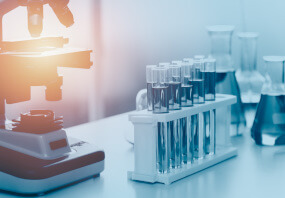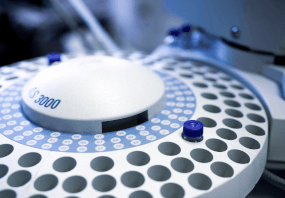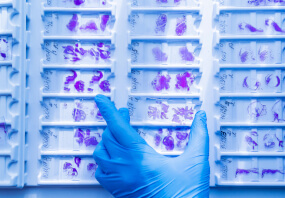Product content:
Component
E665631 50 preps
Buffer P1
30 mL
Buffer P2
30 mL
Buffer E3
30 mL
Buffer PS
15 mL
Buffer PW (concentrate)
10 mL
Endo-Free Buffer EB
10 mL
RNase A (10 mg/mL)
600 μL
Endo-Remover FM
/
with Collection Tubes
50
Spin Columns DL
/
with Collection Tubes
50Product Introduction:Endotoxins are a common pollutant in plasmid extraction. Due to the high sensitivity of eukaryotic cells to endotoxins, the presence of endotoxins in plasmids can greatly reduce the transfection efficiency of eukaryotic cells. This reagent kit provides a simple, fast, and efficient new method for extracting endotoxin free plasmids. The extracted plasmids can remove endotoxins to the maximum extent possible and effectively remove contamination of genomic DNA, RNA, proteins, and other substances. This reagent kit is suitable for extracting 5-15mL of bacterial solution. On the basis of alkaline lysis of cells, it efficiently and specifically binds plasmid DNA through a new silicon-based membrane. Each adsorption column can adsorb up to 100 μ The plasmid DNA of g is effectively removed using a special buffer system and endotoxin removal filter column, effectively removing impurities such as endotoxins and proteins. The plasmid obtained from this kit has high purity and stable quality, making it particularly suitable for cell transfection. It can also be used for downstream experiments such as DNA sequencing, PCR, PCR based mutations, in vitro transcription, transformed bacteria, and endonuclease digestion.Self prepared reagents: anhydrous ethanol, isopropanol.Preparation and important precautions before the experiment:1. All components can be stably stored in a dry, room temperature (15-30 ℃) environment for 1 year, and can be stored at 2-8 ℃ for longer periods of time. Buffer P1 with RNase A added can be stably stored at 2-8 ℃ for 6 months.2. Before the first use, add all RNase A solution to Buffer P1, mix well, and store at 2-8 ℃. Before use, let it sit at room temperature for a period of time. After returning to room temperature, use.3.Before the first use, anhydrous ethanol should be added to the Buffer PW according to the instructions on the reagent bottle label.4. Before use, please check if there is any crystallization or precipitation in Buffer P2 and Buffer E3. If there is any crystallization or precipitation, you can take a water bath at 37 ℃ for a few minutes to restore clarity.5. Be careful not to come into direct contact with Buffer P2 and Buffer E3, and immediately cover them tightly after use.6.The amount and purity of plasmid extraction are related to factors such as bacterial culture concentration, strain type, plasmid size, and plasmid copy number.Operation steps:1. Take 5-15 mL of overnight cultured bacterial solution and add it to a centrifuge tube (self provided). Centrifuge at 13000 rpm (~16200 × g) for 1 minute to collect bacteria, and try to discard all the supernatant as much as possible.2. Add 500 to the centrifuge tube containing bacterial sediment μ L Buffer P1 (please check if RNase A has been added first), mix thoroughly with a pipette or vortex oscillator, and suspend bacterial precipitation. Attention: If the bacterial blocks are not thoroughly mixed, it will affect the cracking effect, resulting in low extraction amount and purity.3. Add 500 to the centrifuge tube μ L Buffer P2, gently invert and mix 8-10 times, allowing the bacterial cells to fully lyse. Leave at room temperature for 3-5 minutes. At this point, the solution should become clear and viscous. Attention: Mix gently and do not shake vigorously to avoid interrupting genomic DNA and mixing genomic DNA fragments in the extracted plasmid. If the solution does not become clear, it indicates that the bacterial count may be too high and the lysis may not be complete. The bacterial count should be reduced.4. Add 500 to the centrifuge tube μ L Buffer E3, immediately invert and mix 8-10 times until white flocculent precipitates appear. Let it stand at room temperature for 5 minutes. Centrifuge at 13000 rpm for 5 minutes, extract the supernatant, and add it to the filter column (Endo Remove FM) (already loaded into the collection tube). Centrifuge at 13000 rpm for 1 minute to filter, then transfer the filtrate from the collection tube to the centrifuge tube (self provided). Attention: 1) After adding Buffer E3, it should be immediately mixed to avoid local precipitation. 2) The maximum volume of the adsorption column is 750 μ L. So please filter the supernatant twice and mix it in the same self provided centrifuge tube.5. Add 450 to the filtrate μ Mix L isopropanol upside down.6. Column balance: Add 200 to the spin columns DL that have been loaded into the collection tube μ L Buffer PS, centrifuge at 13000 rpm for 2 minutes, discard the waste liquid in the collection tube, and place the adsorption column back into the collection tube.7. Transfer the mixed solution of filtrate and isopropanol from step 5 to an equilibrium adsorption column (already loaded into a collection tube). 8.13000 rpm for 1 minute, discard the waste liquid in the collection tube, and place the adsorption column back into the collection tube. Attention: The maximum volume of the adsorption column is 750 μ L. So the solution obtained in step 5 is divided multiple times and passed through the column. 9. Add 750 to the adsorption column μ L Buffer PW (please check if anhydrous ethanol has been added first), centrifuge at 13000 rpm for 1 minute, and discard the waste liquid in the collection tube.10. Place the adsorption column back into the recovery manifold and centrifuge at 13000 rpm for 1 minute.Note: The purpose of this step is to remove residual ethanol from the adsorption column, which can affect subsequent enzymatic reactions (such as enzyme digestion, PCR, etc.).11. Place the adsorption column in a new centrifuge tube (self provided). Specification: 50 preps
- UPC:
- 41105512
- Condition:
- New
- Availability:
- 8-12 weeks
- Weight:
- 17.64 Ounces
- HazmatClass:
- No
- WeightUOM:
- LB
- MPN:
- E665631-50T
- Product Size:
- 50T















